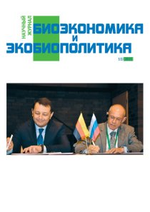Rapid Quantification of Pathogens, Biotoxins and Small Molecules by Flow-Based Chemiluminescence Microarrays
Авторы: Seidel M., Niessner R.
Рубрика: Тезисы
Опубликовано в Биоэкономика и экобиополитика №1 (1) декабрь 2015 г.
Дата публикации: 15.01.2016
Статья просмотрена: 12 раз
Библиографическое описание:
Seidel, M. Rapid Quantification of Pathogens, Biotoxins and Small Molecules by Flow-Based Chemiluminescence Microarrays / M Seidel, R Niessner. — Текст : непосредственный // Биоэкономика и экобиополитика. — 2015. — № 1 (1). — URL: https://moluch.ru/th/7/archive/20/641/ (дата обращения: 25.04.2025).
Microarray technology is an emerging field in analytical chemistry and a powerful analytical tool for the simultaneous detection of multiple analytes in a single sample. A microarray consists of a defined matrix of reaction fields on a supporting material. Biochemically selective receptors like antibodies, DNA or aptamers are deposited by microdispensing and immobilized on a surface by physical or chemical interactions. The generated spots have diameters in the micrometer range. Hundreds or more bioanalytical reactions can be performed on an area of one square centimeter. The reaction on each spot is traceable back by knowing the position of each selective receptor. The multi-analyte method by means of analytical microarrays became a frontier research topic in analytical chemistry due to the possibility of generating multiple sets of quantitative data for different analyte classes in a short time.
Applications are in the field of pharmaceuticals, toxins, allergens, proteins, and (pathogenic) microorganisms and viruses. Multi-analyte quantitative methods are important if a panel of analytes should be quantified. For many different analytes, critical values in food and water safety are defined. Forensics, diagnostics and biosecurity are other fields in analytical chemistry for multiplex analysis. Small organic molecules, proteins, microorganisms, and viruses are quantified by microarray immunoassays (MIAs). Nucleic acids of microorganisms, viruses, or eukaryotic cells are analyzed by nucleic acid amplification tests (NAATs) on DNA microarrays. For multiplex measurement, hybridization assays on DNA microarrays are performed.
In our research institution is developed the flow-based chemiluminescence microarray analysis platform MCR 3. Pathogens, proteotoxins and small molecules are quantified rapidly with high sensitivity by DNA and antibody microarrays [1]. Following applications are presented in the lecture: Antibiotics in milk, biotoxins in food samples, zoonotic pathogens in slaughtered pigs, hygiene control of food and water by quantification of pathogenic microorganisms and viruses.
[1] Seidel, M. and Niessner, R., Chemiluminescence microarrays: a critical review. Analytical and Bioanalytical Chemistry 2014,406, 5589–5612.







